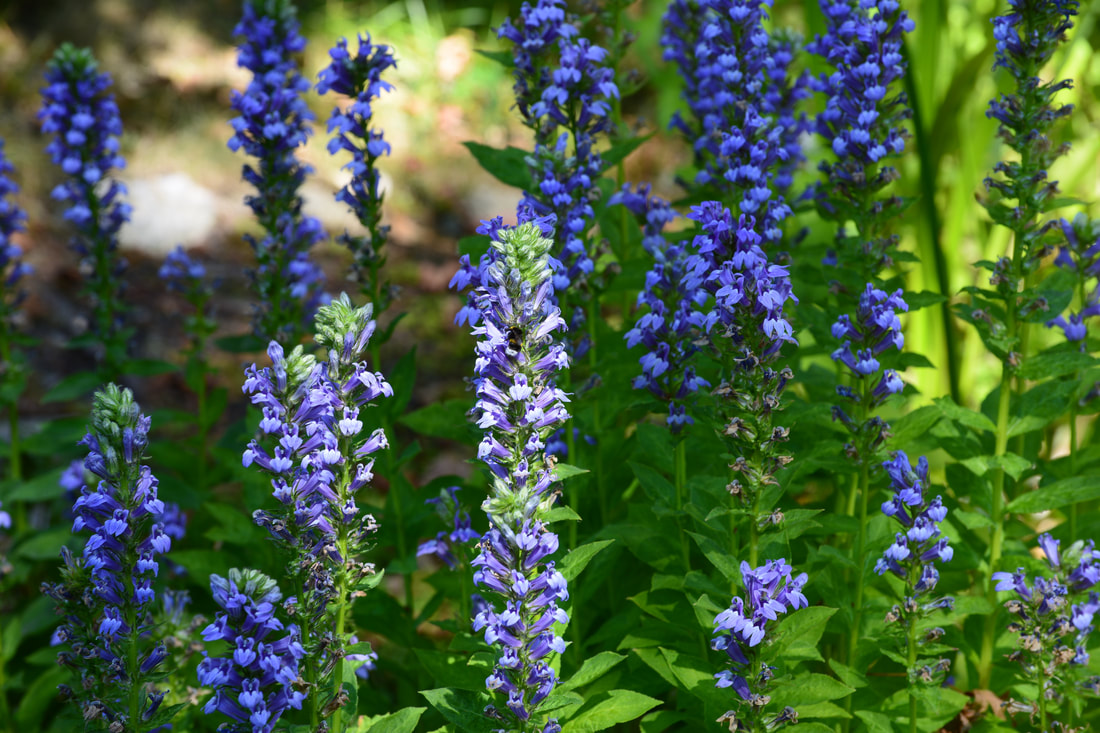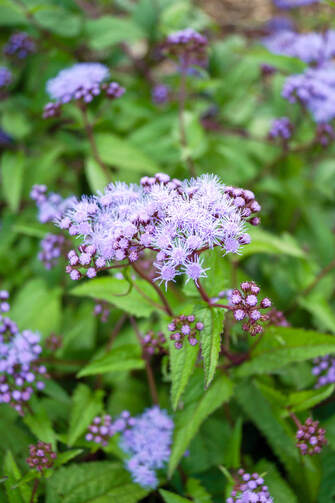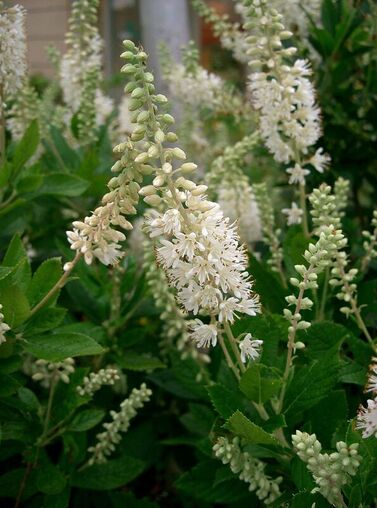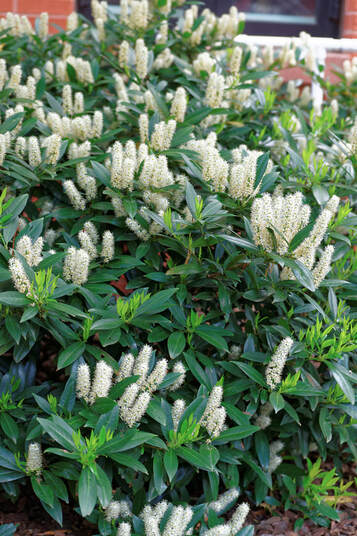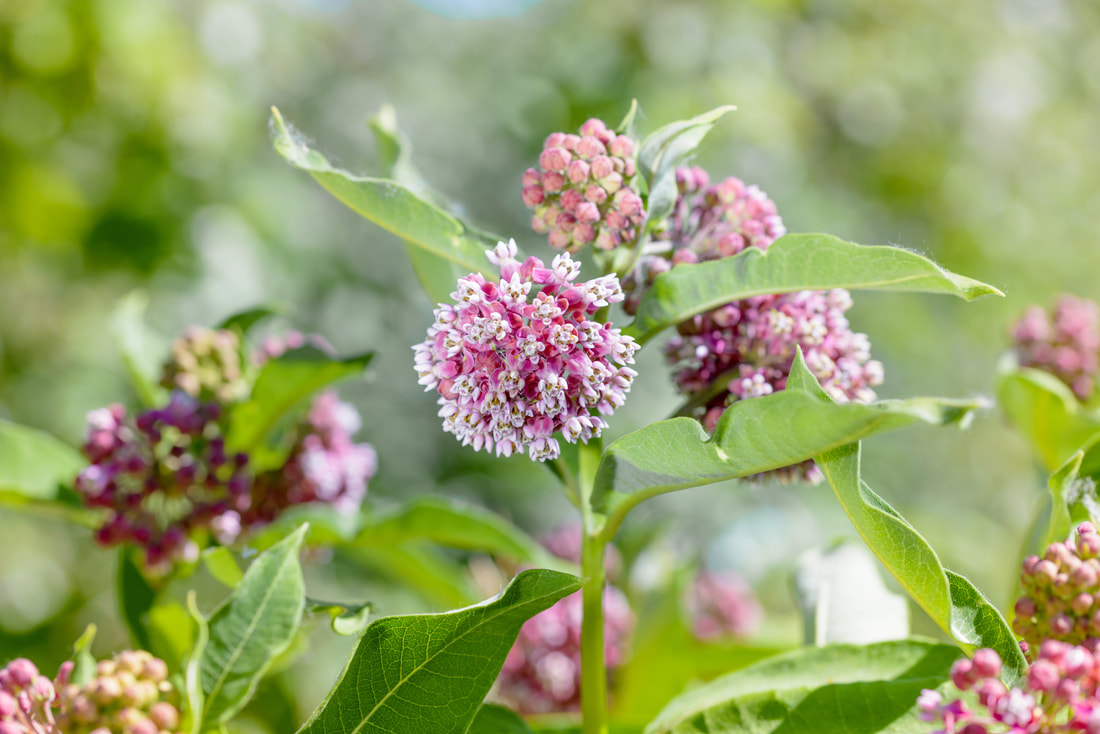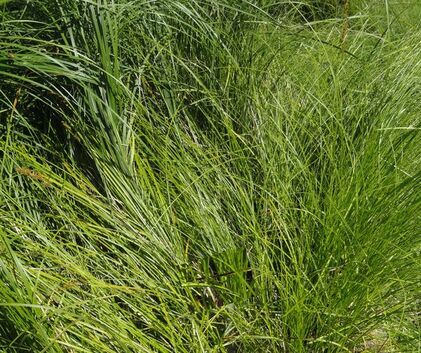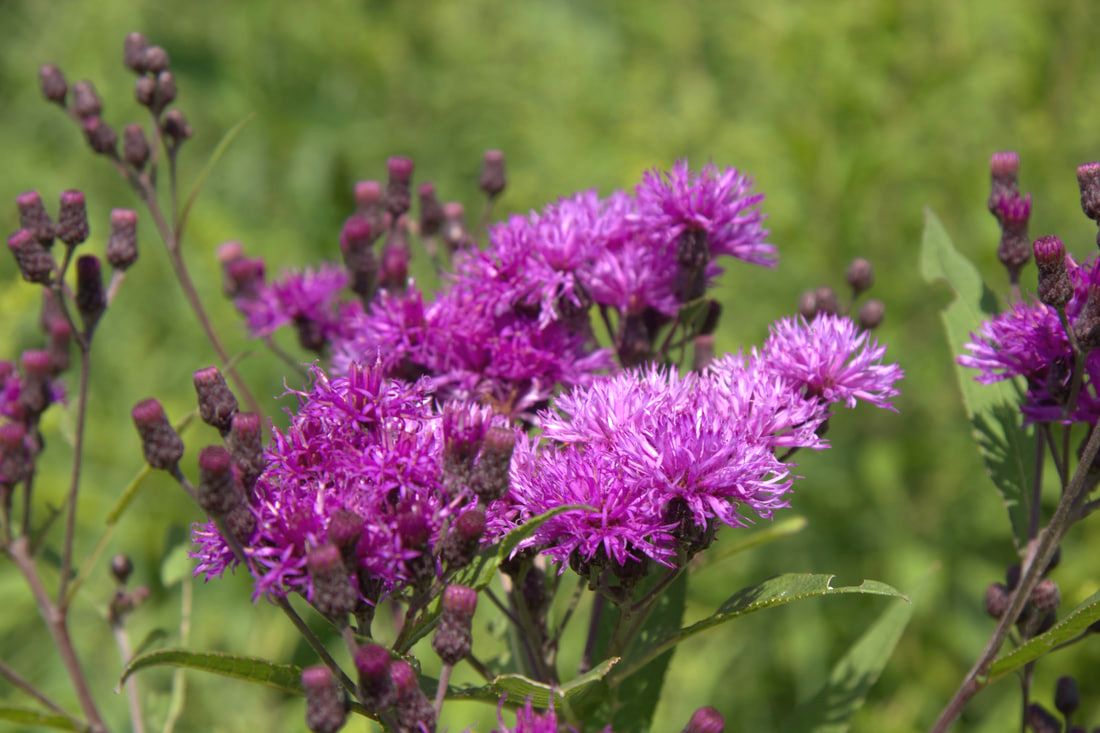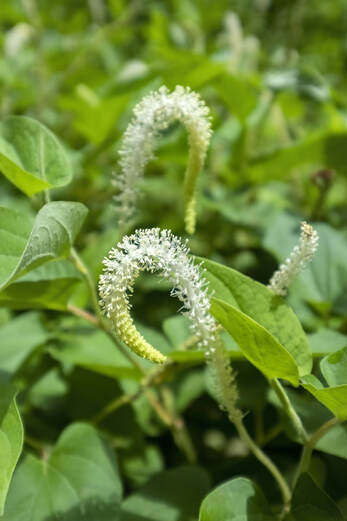Just a few of the native perennials and shrubs that will be available at the 2021 Fall Plant Sale, part of the Fall Gardening Festival.
|
Great Blue Lobelia, Big Blue Cardinal Flower (Lobelia siphilitica) is a native herbaceous clump-forming perennial that provides welcome late summer blooms wherever it is planted. It displays blue, tubular flowers on 2-3 ft stiff stalks from July through October. It grows and blooms in a variety of light conditions from deep shade to partial shade to full sun. Great Blue Lobelia flourishes in soil high in organic matter that is moist to occasionally wet thus making it an excellent choice for a rain garden, pollinator garden or in a border or woodland garden. It is deer resistant and attracts butterflies, hummingbirds, and other pollinators. This plant provides food for wildlife most of the year until losing its leaves after a heavy frost.
|
|
The Obedient Plant (Physostegia virginiana) is a native plant in the mint family and gets its name from the ability of the flowers on the stalk to be twisted into any position, where they will remain. Pink, purple, or lavender flowers bloom from August through November on erect, multi-stemmed stalks reaching 3-4 feet tall in a clump 2-3 feet wide. The flowers make good cut flowers. It grows best in moist, well-drained fertile soil in full sun to part shade. Soil requirements include a wide range from clay to loam to sand. Obedient Plant tolerates occasionally wet soil as well as moist soil if there is good drainage. These versatile plants work well in containers, naturalized areas, by a patio or walkway, or in a woodland setting. It would be an excellent addition to a rain garden. Obedient Plants attract bees, butterflies, hummingbirds, and other pollinators and is a wildlife food source.
|
|
Blue Mist Flower (Conoclinium coelestinum) is a herbaceous perennial wildflower, native to the United States. It has a long bloom period from July to October displaying small 1/2 inch lavender, blue or pink flowers. It has a clumping, spreading habit, growing quickly in moist soil. It flourishes in full sun to part shade with soil high in organic matter. It would be a showy addition to a pollinator or water garden. It is nectar rich and attracts butterflies, moths, and pollinators of all sorts as well as songbirds. Songbirds devour the seeds. It is resistant to deer, and wet soil, tolerating some flooding.
|
|
Early Sunflower/Ox Eye (Heliopsis helianthoides) is an herbaceous perennial wildflower, native to central and eastern North America. It grows in a variety of soils from clay to loam to sand in occasionally dry to moist soil. Full sun encourages the best growth, but it will grow in part shade reaching 3-5 ft tall by 1-3 ft wide in clumps. Ox Eye produces 1-3 inch flowers ranging in color from copper to gold/yellow to orange from May to October. The flowers work well in a vase. It attracts butterflies, hummingbirds, songbirds, and pollinators of many kinds. Song birds eat the seeds. It would be a great addition to a cottage or cutting garden. Ox Eye is resistant to drought, dry or poor soil, erosion, and heat.
|
|
Soft Rush (Juncus effusus) is a perennial, wetland grass. It is found across the United States in almost every state. It grows in full sun to part shade in bogs, marshes and swamps and is widespread in the world. Soft Rush grows in spreading, erect clumps 1-3 ft tall in wet soil. It has fine, smooth stems. Greenish brown small scaly flowers bloom from July to September. In zones with warm winters, Soft Rush will stay evergreen. In cooler climates, the foliage becomes yellow, then brown in fall to winter dying back to the ground. Soft Rush functions well on a slope or in a naturalized area and will grow well in a container.
|
|
Sweet Pepperbush (Clethra alnifolia) is a deciduous shrub native to eastern North America found in swamps, damp thickets, and sandy woods. It reaches 5-10 ft tall and 4-6 ft wide growing in full sun to deep shade. Soil requirements vary from sand to loam to clay soil. It requires good drainage but will thrive in moist or occasionally wet soil. Fragrant white flowers bloom in the summer from June to July as dense, narrow spikes 2-6 inches long. Sweet Pepperbush attracts bees, butterflies, hummingbirds, small mammals, and songbirds. Fruits are eaten by birds and small mammals. It is resistant to deer and heavy shade and helps to control erosion. It tolerates salt water.
|
|
Virginia Sweetspire (Itea virginica) is a native deciduous, semi-evergreen shrub. It has arching branches with 2-6 inch long columns of small, white flowers at the tips from May to June which bloom on the previous year’s growth. It grows in clumps reaching 4-8 ft tall and 3-6 ft wide, spreading by suckers to form dense colonies. The leaves turn a showy red, orange and gold in the fall and persist until winter. It grows in part shade to dappled sunlight in soil that is moist to occasionally wet requiring good drainage. This quality makes it an excellent choice for a rain garden. It would also do well in a pollinator garden as it attracts butterflies and hummingbirds as well as small mammals and songbirds who eat the seeds. It is resistant to deer and drought.
|
|
Blue Verbena, Swamp Vervain (Verbena hastata) is a native wildflower which grows in moist areas. It forms clumps of stiff, upright stems reaching 2-5 ft tall by 1-2 ft wide. It boasts showy panicles of purplish-blue flowers that grow to 6 inches long in the summer on candelabra-like stems, blooming a few at a time from the bottom up. Blue Verbena does well in full sun to partial shade in medium to wet soils. It attracts butterflies, songbirds, many pollinators, and several specialized bees. It is the larval host plant for the verbena moth and the common buckeye butterfly. In addition, the thread-waisted wasp, bee flies, thick-headed flies and golden soldier beetle are also known to eat the nectar of blue vervain. Blue Verbena tolerates wet soil so it would do well in a rain garden.
|
|
Common Milkweed (Asclepias syriaca) is a deciduous, native, herbaceous perennial wildflower that grows in a wide variety of soils. It is erect, growing rapidly to 3-5 ft tall and 8-12 inches wide, naturalizing in the garden. The flowers are green, pink, purple, and white and 1-3 inches long, blooming June through August. The Common Milkweed attracts bees, butterflies, many pollinators, songbirds, and specialized bees. It is the larval host plant of the Monarch butterfly and the milkweed tussock moth. It is also food for the milkweed weevil and the milkweed longhorn beetle. It is resistant to deer drought, dry soil, erosion, and poor soil.
|
|
Fox Sedge (Carex vulpinoidea) is a robust perennial rush or sedge native to North America which grows well in damp to very wet soils in full sun to partial shade. It will grow in average soil rapidly reaching 1-3 ft tall by 1/2 - 2 ft wide in a clump forming small colonies from short underground rhizomes. Bloom time is from May to July with small, stiff, green inflorescences. Seed heads from the mature flowers radiate from the center of the clump look somewhat like a fox’s tail hence the name. The foliage is delicate and arching and often evergreen. Fox Sedge grows near water or in a swamp. Fox Sedge is resistant to deer and other herbivores, provides habitat and cover for birds and acts as host plant for skipper butterflies. It is an excellent choice for bare soil that needs to be covered to prevent erosion.
|
|
Ironweed (Vernonia noveboracensis) is a native herbaceous perennial wildflower in the Aster family. It grows 5-8 ft tall and 3-4 ft wide in loamy or clay soil in full sun to partial shade. Tiny flowers emerge in July to September with purple/lavender inflorescence in 3-4 inch wide terminal clusters. Rusty colored seeds follow from August to October. The flowers make good cut flowers. The flowers attract butterflies, specialized bees and other pollinators and songbirds eat the seeds. It works well in a rain garden, pollinator garden, naturalized area, pond, and other locations. It is resistant to deer and tolerates wet soil.
|
|
Lizard's Tail (Saururus cernuus) is a deciduous herbaceous perennial native wildflower which grows in swamps and on the edge of a pond or in the water in containers. It rapidly grows to 1-4 ft tall by 1-2 ft wide forming colonies of erect, spreading plants. Lizards Tail grows in full sun to part shade in clay to loam to silt soil. The flowers are 4-6 inches long and droop thus the name Lizard's Tail. The white flowers are attractive and fragrant blooming from August to November. The fruit that follows is green, resembling a wart, from August to November. Lizard's Tail provides cover for wood ducks and other small animals. It would do well in a rain, water, or shade garden or in a naturalized area, pond, or container. It is resistant to deer, diseases, insect pests and tolerates heavy shade as well as wet soil.
|
